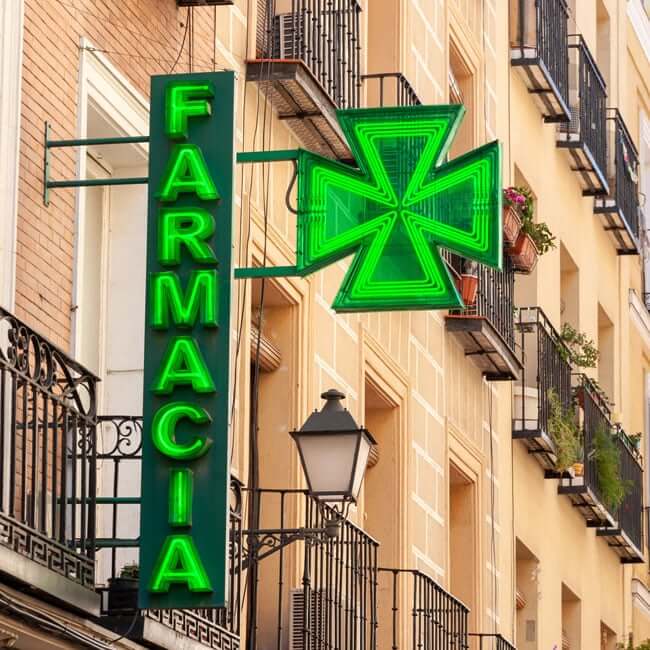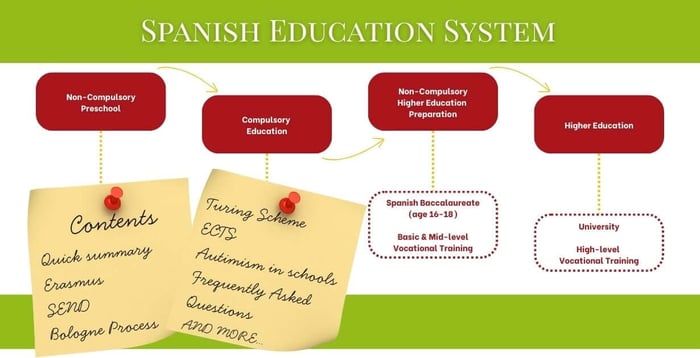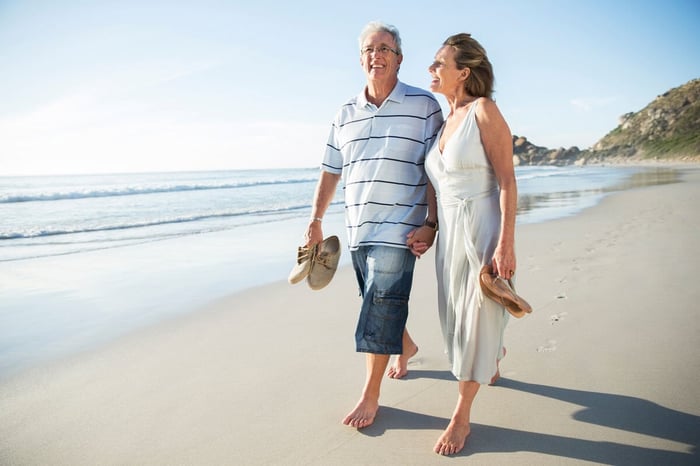Table of Contents
- About The Healthcare System in Spain
- Are you looking to buy or sell property in the Guadalhorce Valley?
- The Public Healthcare System in Spain (SNS)
- Healthcare on the Costa del Sol
- Healthcare System in Spain for Retirees
- Can I use an S1 form in Spain after Brexit?
- How to apply for and use an S1 form in Spain
- What is the Withdrawal Agreement?
- Other UK Healthcare Cards and Forms
-
- How to Get and Use an S1 Form
- S1 Registration To-Do List (for UK Expats)
- Healthcare in Spain for Digital Nomads
- Healthcare in Spain for Families
- Pharmacies and Everyday Healthcare in Spain
- Useful Spanish Phrases For Describing an Illness or Ailment
- Nut Allergy Travel Card
About The Healthcare System in Spain
Relocating to Spain offers more than just stunning beaches, rich culture, and sunny weather—it's also about ensuring you and your family have access to outstanding world-class healthcare. Whether you’re planning to retire, work remotely (Digital Nomad), or raise your children here, the healthcare system in Spain is one of the best in Europe. In this article, we will focus on several healthcare options and other UK healthcare cards and forms available to use on the Costa del Sol.
While we aim to provide helpful information, we always recommend seeking professional legal advice, as laws and healthcare regulations can change.
Are you looking to buy or sell property in the Guadalhorce Valley?
Mediterranean Homes is an estate agency based in Coín, Andalucia. We specialise in the sale of rural properties in Coín, Mijas, Alhaurin El Grande, Monda and all other surrounding areas of the Guadalhorce Valley.
The Public Healthcare System in Spain (SNS)
Can anyone access the Healthcare system in Spain?
Spain's public healthcare system, known as the Sistema Nacional de Salud (SNS), is universal, meaning it's available to all residents, whether Spanish nationals or expats. The system is funded through taxes and Social Security contributions.
Key Benefits:
- Free or low-cost medical care for all residents.
- Access to general practitioners (GPs), specialists, and emergency services.
- Affordable medications (with a small co-pay, depending on income).
Who’s Eligible?
- Working residents: Automatically covered by Social Security contributions.
- Self-employed residents: Must pay monthly into the Social Security system for healthcare access.
- EU/EEA citizens: Use the European Health Insurance Card (EHIC) for temporary stays; long-term residents should register with the system.
- Non-EU residents: Must either use private insurance or pay into the Convenio Especial scheme for full coverage.
What is the Convenio Especial Spain?
The Convenio Especial is a voluntary healthcare program that enables individuals to access the healthcare system in Spain for a current monthly fee of:
Under 65 years €60 Over 65 and above €157
This program is particularly suitable for non-EU citizens who are not employed in Spain and, therefore, are not contributing to the Social Security system, therefore, making this a common pathway for residents to access public healthcare. The program provides access to most medical services available through the Spanish healthcare system; however, some limitations apply regarding specific treatments, orthopaedic supplies, dietary supplements, and prescriptions.
Private Health Insurance
While the public healthcare in Spain is excellent, many expats choose to invest in private health insurance for the benefits of faster service, English-speaking doctors, and more flexible healthcare options.
What Does Private Insurance Cover?
- Doctor visits without long wait times.
- Access to private hospitals and clinics, such as Hospiten Estepona and Quirónsalud Marbella.
- Specialist consultations and medical tests are often available on the same day.
- Access to multilingual professionals which is especially useful for those still learning Spanish.
How Much Does Private Insurance Cost?
Private health insurance typically costs €50–€120 per month, depending on the provider, age, and coverage level. Popular providers in Spain include:
Healthcare on the Costa del Sol
The Costa del Sol is not only known for its beautiful coastline and Mediterranean lifestyle, it also boasts excellent healthcare facilities. Whether you are living in Marbella, Málaga, or Estepona, you’ll have access to world-class hospitals and clinics.
Public Healthcare on the Costa del Sol
Hospital Costa del Sol (Marbella) – one of the top-rated public hospitals in the region.
Hospital Regional Universitario de Málaga – offers specialised services and high-tech treatments.
Centro de Salud clinics are located throughout towns for routine doctor visits and preventative care.
Private Healthcare on the Costa del Sol
Hospiten Estepona and HC Marbella International Hospital are two major private hospitals catering to international clients.
Quirónsalud Marbella offers a wide range of specialised services and is a popular choice for English-speaking expats.
These healthcare centres are staffed with highly qualified professionals and equipped with the latest medical technologies. Many of them also offer English-speaking services, which makes it easy for expats to receive care without the language barrier.

Healthcare System in Spain for Retirees
Retiring on the Costa del Sol is a dream come true for many, thanks to the relaxed lifestyle, great weather, and affordable living. As a retiree, you’re entitled to public healthcare in Spain, but how you access it depends on your nationality and residency status.
EU Retirees
If you're from the EU, you can use the S1 form (from your home country’s health system) to register with the Spanish public health system.
Non-EU Retirees
As mentioned above, you can purchase private health insurance or apply for Convenio Especial, which allows you to buy into the public healthcare system at a reasonable cost.
Retirees also enjoy lower prescription costs and priority care for age-related issues.
Can I use an S1 form in Spain after Brexit?
The S1 form is an important document for people moving between European countries, especially retirees, and after Brexit, UK retirees can still use the S1 under the Withdrawal Agreement. Here is a simple explanation:
- The S1 form allows you, as an EU citizen (or someone covered by EU rules, like Brits with a Withdrawal Agreement), to transfer your healthcare rights from your home country to Spain (or another EU country).
- It means your home country will pay for your healthcare while you are living abroad, and you can access the public health system in Spain just like a local resident, often free or at a very low cost.
Who can use a S1 form?
- State pensioners retiring to Spain.
- Frontier workers (people who live in one country but work in another).
- Dependants of someone who qualifies.
- Some people receive incapacity benefits or similar long-term benefits.
How do you use a S1 form?
- Apply for the S1 form through your home country's health or social security department.
- Register the S1 form with the Spanish authorities (often at your local INSS office, Instituto Nacional de la Seguridad Social).
- Once registered, you will be issued a health card (tarjeta sanitaria), giving you access to public healthcare in Spain.
Why is it useful?
- No need to take out expensive private insurance.
- You get healthcare as if you were a Spanish resident.
- It covers long-term care, hospital visits, and prescriptions (with the usual small co-payment).
How to apply for and use an S1 form in Spain
Step 1: Request your S1 Form (this process may take a few weeks, so apply early)
- If you are from the UK, contact NHS Overseas Healthcare Services (part of the NHS Business Services Authority).
- If you are from another EU country, contact your national health service or social security office.
- Tell them you are moving to Spain and need an S1 form to register for healthcare.
Step 2: Receive your S1 form
- They will post the form to you
- The S1 form usually has two copies, one for the Spanish authorities and one for your records.
Step 3: Register the S1 in Spain
Go to your nearest INSS office (Instituto Nacional de la Seguridad Social).
Take with you the following:
- Your passport (or national ID)
- Your residency certificate/card in Spain (TIE or green residency certificate)
- Your S1 form
- Proof of your Spanish address (like a utility bill or a padron certificate/empadronamiento)
Important: You often need to book an appointment online (cita previa) for the INSS office.
Step 4: Get Your Spanish Healthcare Card
After registering, the INSS will give you a certificate showing you are entitled to healthcare.
Then, you take this certificate to your local Centro de Salud (health centre) to apply for your Tarjeta Sanitaria (Spanish health card).
This card then entitles you to the following:
- Book doctor's appointments
- Access Specialist care
- Use the Hospital and pharmacies at resident rates
Quick Reminder:
The S1 form is mainly for state pensions, long-term benefit claimants and frontier workers.
If you are working and paying into Spain's system, you will not use an S1. You will be covered through Social Security instead.
After Brexit, UK retirees can still use the S1 under the Withdrawal Agreement.

What is the Withdrawal Agreement?
A Withdrawal Agreement is the official deal that was made between the United Kingdom and the European Union when the UK decided to leave the EU, also known as Brexit. Here is what it means, especially for individuals:
It protects the rights of UK citizens who were already living in an EU country (like Spain) before 31 December 2020.
It also protects EU citizens living in the UK.
It ensures that people covered by the agreement can continue living, working, studying, and accessing healthcare where they were, under similar conditions before Brexit.
Key rights protected by the Withdrawal Agreement:
Residency
You can stay in the EU country where you were living before Brexit.
Healthcare
You keep your right to public healthcare, for example, by using an S1 form if you are a pensioner.
Work and Study
You can carry on working or studying without needing a new visa or work permit
Things like pensions, disability benefits and healthcare entitlements continue.
Important: If you moved to Spain after 1 January 2021, you are not automatically covered by the Withdrawal Agreement; you would fall under Spain's new immigration and healthcare rules.
If you were living legally in Spain before Brexit and registered properly, with the Withdrawal Agreement means your right to healthcare, residency, and benefits continues, almost as if Brexit had not happened.
Other UK Healthcare Cards and Forms
- UK GHIC, (UK Global Health Insurance Card)
- UK EHIC, (UK European Health Insurance Card)
- PRC, (Provisional Replacements Certificate)
- S1
- S2
1. UK GHIC (UK Global Health Insurance Card)
Replaces the old UK EHIC after Brexit.
A free card that gives access to state-provided healthcare during temporary stays in EU countries.
Covers medically necessary treatment (eg, emergencies, existing conditions).
Not valid outside the EU (except for a few special agreements).
2. UK EHIC (UK European Health Insurance Card)
For UK citizens who had rights before 31 December 2020.
Still valid until its expiry date.
Works just like the GHIC, providing access to public healthcare when visiting EU countries.
After expiry, you must apply for GHIC unless covered under special Withdrawal Agreement rules.
3. PRC (Provisional Replacement Certificate)
A temporary document if you need urgent healthcare but do not have your EHIC or GHIC with you.
Acts as proof that you are entitled to public healthcare abroad.
You can request one from NHS Overseas Healthcare Services (UK).
4. S1 Form
For people living abroad long-term (like pensioners or certain benefit claimants).
Allows you to register for public healthcare in another EU country (eg; Spain).
Your home country pays for your healthcare costs.
Ideal for retirees moving to Europe.
5. S2 Form
- Allows you to travel abroad specifically for medical treatment.
- Your home country agrees to pay for pre-approved treatment in another EU country.
- Often used for surgeries or specialist care not available at home, without long wait times.
- Please see below a quick comparison table highlighting the differences between the above forms.
| Name | What It's For | Who It's For | Covers | Valid Where |
| UK GHIC | Access emergency or necessary healthcare during short trips | UK residents travelling temporarily to the EU | State healthcare at same cost as locals | EU countries (some non-EU agreements coming soon) |
| UK EHIC | Same as GHIC but for those with rights from before Brexit | UK citizens who applied before 31 December 2020 | State healthcare at the same cost as locals | EU Countries |
| PRC | Temporary proof if you forget or lose your EHIC/GHIC | Anyone eligible for EHIC/GHIC | State healthcare in emergencies | EU Countries |
| S1 | Long-term healthcare registration in another EU country | Pensioners, benefit recipients, and frontier workers | Full access to public healthcare | Country of residence (eg; Spain, France) |
| S2 | Planned medical treatment abroad | UK residents needing pre-approved care | Specific pre-agreed treatment abroad | EU Countries |
- GHIC/EHIC/PRC = Short-term stays and holidays.
- S1 = Living abroad permanently.
- S2 = Travelling specifically for planned healthcare.
Here’s the official step-by-step guide for getting and using an S1 form after Brexit (based on the current 2024 NHS Overseas Healthcare Services advice):
How to Get and Use an S1 Form
(Correct from the last update in 2024)
1. Check if You’re Eligible
You can apply for an S1 form if you are:
- Receiving a UK State Pension.
- Receiving a qualifying exportable benefit (e.g., long-term incapacity benefit).
- A frontier worker (living in one country, working in another).
- A dependent of someone entitled to an S1.
Important: You must not be employed or self-employed in your new country if applying as a pensioner — otherwise, you'll need to pay into their healthcare system.
2. Apply for Your S1 Form
- Contact NHS Overseas Healthcare Services:
- Telephone: +44 (0)191 218 1999 (Monday to Friday, 8am to 6pm UK time)
- Or apply by post — forms and details are on the NHS website.
You will need to provide:
- Your National Insurance number.
- Proof that you are receiving a qualifying pension or benefit.
- Your address in the EU country (e.g., Spain).
3. Register Your S1 Form Locally
Once you receive your S1:
- Take it to the local Social Security office (INSS in Spain) or local health authority.
- Register it to get entitlement to public healthcare.
- After registration, you’ll be issued a healthcare registration certificate.
4. Get Your Health Card
- Take your registration certificate to your local Centro de Salud (health centre).
- Apply for your Tarjeta Sanitaria (health card).
- This card allows you to book appointments, see specialists, and get subsidised prescriptions.
Useful Tips:
- If you move to a different EU country, you must reapply for a new S1.
- The S1 does not cover private healthcare — it only covers public services.
- Healthcare is provided on the same terms as local citizens in the country where you live.
Why Use an S1?
You won't need expensive private health insurance.
You have direct access to the country’s public health system.
Your UK-based healthcare rights stay protected even after Brexit!
Here’s a simple, friendly one-page checklist you can use as an "S1 Registration To-Do List"
S1 Registration To-Do List (for UK Expats)
Planning to live in Spain (or the EU) and want access to public healthcare?
Here’s what you need to do:
Step 1: Check Your Eligibility
☐ Are you receiving a UK State Pension?
☐ Are you receiving a qualifying exportable benefit?
☐ Are you a frontier worker or a dependent?
Step 2: Apply for Your S1 Form
☐ Contact NHS Overseas Healthcare Services: +44 (0)191 218 1999
☐ Provide your National Insurance number and EU address.
Step 3: Receive Your S1 Form
Keep it safe — you’ll need it to register locally.
Step 4: Register Your S1 Form in Spain
Book a cita previa (appointment) at the INSS office.
Bring:
- Your S1 form
- Your passport
- Your residency card (TIE or green certificate)
- Proof of address (e.g., utility bill)
Step 5: Get Your Health Card
☐ Take your INSS certificate to your Centro de Salud.
☐ Apply for your Tarjeta Sanitaria (health card).
Step 6: Enjoy Public Healthcare
☐ Use your health card to see doctors, specialists, and get prescriptions — just like a local!
Healthcare in Spain for Digital Nomads
Spain’s Digital Nomad Visa makes it easier for remote workers to live in Spain while maintaining access to excellent healthcare. While waiting for your Social Security registration, you’ll need private health insurance to cover your healthcare needs.
What Digital Nomads Should Know
- Many private healthcare providers offer flexible plans that work well for nomads.
- Hospitals like Quirónsalud Marbella provide premium services to international clients.
- You can switch to public healthcare once you've paid into Spain’s Social Security system.
Healthcare in Spain for Families
Spain is a fantastic place to raise a family, with plenty of activities, educational options, and top-notch healthcare for children. If you're relocating with children, they’ll be covered by your healthcare registration (as long as you're registered with Social Security or private insurance).
What’s Covered for Children?
Regular check-ups and vaccinations are available through Centro de Salud clinics.
Emergency care is free for children under 18.
Many international schools offer on-site health support, and plenty of paediatricians and family clinics with English-speaking staff.

Pharmacies and Everyday Healthcare in Spain
Spain has a high density of pharmacies (farmacias), and they’re not just for picking up medicine. Pharmacists are often very knowledgeable and can offer advice on common ailments, saving you a trip to the doctor for minor issues.
Pharmacy Tips
Farmacias are easy to find in towns, cities, and along the coast and are often recognisable by an illuminated green cross symbol.
You can visit a pharmacy for things like minor health concerns, over-the-counter medications, and even small medical consultations.
Useful Spanish Phrases For Describing an Illness or Ailment
Learning vocabulary related to sickness is incredibly important for practical, real-life situations. Here's a handy breakdown of essential Spanish health vocabulary and phrases for English speakers:
Basic symptoms and conditions
First, let’s look at some common symptoms (los síntomas) and conditions (las condiciones):
Fever: la fiebre
Cough: la tos
Cold: el resfriado
Flu: la gripe
Headache: el dolor de cabeza
Stomach-ache: el dolor de estómago
Sore throat: el dolor de garganta
Runny nose: la nariz que moquea
Nausea: las náuseas
Vomiting: los vómitos
Understanding these basic terms can help you explain how you’re feeling or understand what others are experiencing. For example, if you have a fever, you can tell someone,
“Tengo fiebre,” which means “I have a fever.”
Medical conditions
Beyond basic symptoms, there are more specific medical conditions (las condiciones médicas) that you might need to describe or understand:
Asthma: el asma
Diabetes: la diabetes
Hypertension: la hipertensión
Allergy: la alergia
Infection: la infección
Migraine: la migraña
Arthritis: la artritis
If you suffer from one of these conditions, it’s important to be able to communicate this. For instance,
“I have asthma” translates to “Tengo asma.”
Describing pain
Describing pain (el dolor) accurately, is also important.
Sharp pain: el dolor agudo
Dull pain: el dolor sordo
Burning pain: el dolor ardiente
Throbbing pain: el dolor palpitante
Chronic pain: el dolor crónico
Acute pain: el dolor agudo
When visiting a doctor, you might be asked to describe your pain. Saying
“I have a sharp pain in my chest” would be “Tengo un dolor agudo en el pecho” in Spanish.
Common phrases in medical situations
Here are some phrases that could be useful in medical situations:
I need a doctor: Necesito un doctor.
I’m not feeling well: No me siento bien.
I need help: Necesito ayuda.
I have an emergency: Tengo una emergencia.
I am allergic to…: Soy alérgico/a a…
Where is the hospital? ¿Dónde está el hospital?
Medications and treatments
Finally, knowing some common terms for medications (los medicamentos) and treatments (los tratamientos) can be very helpful:
Medicine: la medicina
Prescription: la receta médica
Antibiotics: los antibióticos
Painkillers: los analgésicos
Injection: la inyección
Surgery: la cirugía
Bandage: la venda
For instance, “I need painkillers” translates to “Necesito analgésicos.”
Here's a helpful list of common ailments in Spanish with their English translations. This is great for both practice and real-world use when you're abroad, at the doctor’s office, or even chatting with Spanish-speaking friends.
Nut Allergy Travel Card
When traveling abroad, it is always handy to have on your possession at all times an allergy card if you have any serious allergies. Here are some templates to use as translations into Spanish.
| Spanish: |
| ¡Atención! Tengo una alergia severa a los frutos secos. Por favor, no me sirvan ningún alimento que contenga o haya estado en contacto con frutos secos (como nueces, almendras, avellanas, etc.). Esta alergia puede causar una reacción grave. ¡Gracias por su comprensión! |
| English Translation: |
Attention! I have a severe nut allergy. Please do not serve me any food that contains or has come into contact with nuts (such as walnuts, almonds, hazelnuts, etc.). This allergy can cause a serious reaction. Thank you for your understanding! |
| Spanish |
¡Atención! Tengo alergias alimentarias. Por favor, no me sirvan ningún alimento que contenga o haya estado en contacto con los siguientes ingredientes: Frutos secos (nueces, almendras, avellanas, etc.) Lácteos (leche, queso, mantequilla, etc.) Gluten (trigo, cebada, centeno, etc.) Mariscos (camarones, langosta, cangrejo, etc.) Huevos Estas alergias pueden causar reacciones graves. ¡Gracias por su comprensión! |
| English Translation |
Attention! I have food allergies. Please do not serve me any food that contains or has come into contact with the following ingredients: Nuts (walnuts, almonds, hazelnuts, etc.) Dairy (milk, cheese, butter, etc.) Gluten (wheat, barley, rye, etc.) Shellfish (shrimp, lobster, crab, etc.) Eggs These allergies can cause severe reactions. Thank you for your understanding! |
| Spanish | English |
| Dolor de cabeza | Headache |
| Dolor de estómago | Stomach-ache |
| Dolor de garganta | Sore throat |
| Fiebre | Fever |
| Resfriado | Cold |
| Gripe | Flu |
| Náuseas | Nausea |
| Mareo | Dizziness |
| Tos | Cough |
| Congestión nasal | Nasal congestion / Stuffy nose |
| Diarrea | Diarrhoea |
| Estreñimiento | Constipation |
| Dolor muscular | Muscle pain |
| Dolor en las articulaciones | Joint pain |
| Alergia | Allergy |
| Infección | Infection |
| Herida | Wound / Injury |
| Quemadura | Burn |
| Picadura de insecto | Insect bite |
| Ansiedad | Anxiety |
| Spanish | English |
| Dolor de cabeza | Headache |
| Dolor de estómago | Stomach-ache |
| Dolor de garganta | Sore throat |
| Fiebre | Fever |
| Resfriado | Cold |
| Gripe | Flu |
| Náuseas | Nausea |
| Mareo | Dizziness |
| Tos | Cough |
| Congestión nasal | Nasal congestion / Stuffy nose |
| Diarrea | Diarrhea |
| Estreñimiento | Constipation |
| Dolor muscular | Muscle pain |
| Dolor en las articulaciones | Joint pain |
| Alergia | Allergy |
| Infección | Infection |
| Herida | Wound / Injury |
| Quemadura | Burn |
| Picadura de insecto | Insect bite |
| Ansiedad | Anxiety |





